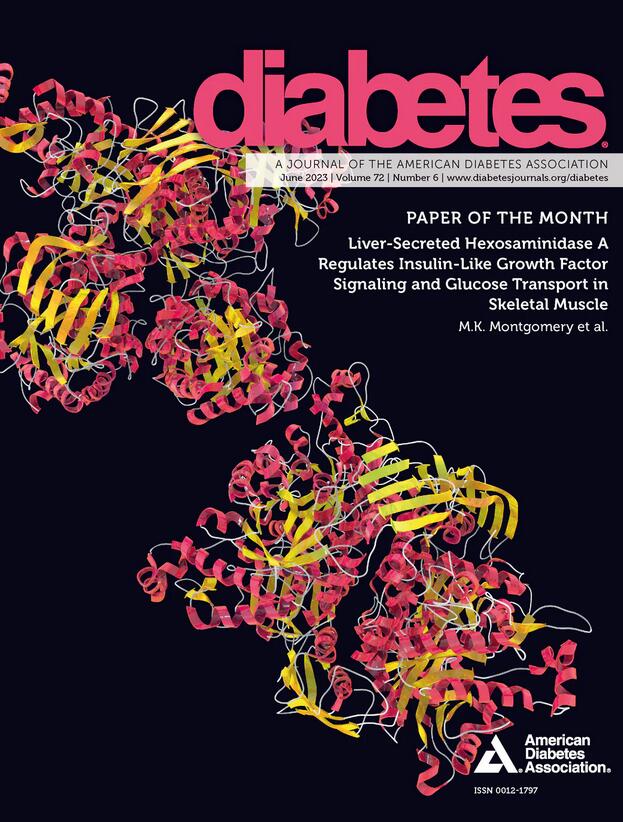药理激活 PDC 通量可逆转运动后恢复过程中脂肪对肌肉中胰岛素作用的抑制
IF 6.2
1区 医学
Q1 ENDOCRINOLOGY & METABOLISM
引用次数: 0
摘要
胰岛素抵抗是 2 型糖尿病的一个风险因素,而运动可以提高胰岛素敏感性。然而,运动后高浓度的循环脂肪酸(FA)可能会抵消这一作用。我们假设,通过药物激活丙酮酸脱氢酶复合物(PDC),强行增加碳水化合物的氧化,可以减少这种抑制作用。我们采用交叉设计对健康年轻男性(n = 8)进行了胰岛素刺激的葡萄糖摄取进行了研究,研究人员在单腿运动五小时后,在高胰岛素血糖钳夹下对之前运动过的腿和休息过的腿进行了研究:1)输注生理盐水;2)输注模仿全身运动恢复期间循环脂肪酸水平的内脂;3)输注内脂+口服 PDC 激活剂二氯乙酸(DCA)。输注内脂可使先前运动过的腿部在胰岛素刺激下的葡萄糖摄取量减少 19%,而在对侧休息的腿部则未观察到这种情况。有趣的是,运动腿的内脂作用被 DCA 所消除,DCA 增加了肌肉 PDC 的活性(130%)和通量(乙酰肉碱 130%),并降低了 PDC 在 Ser293(∼40%)和 Ser300(∼80%)上的抑制性磷酸化。这为研究运动恢复过程中葡萄糖和脂质代谢之间的相互作用提供了新的视角。将运动和 PDC 通量激活耦合在一起可同时提高葡萄糖转运(运动)和氧化(DCA)的能力,这似乎是在恢复过程中充分刺激胰岛素刺激的葡萄糖摄取所必需的。本文章由计算机程序翻译,如有差异,请以英文原文为准。
Pharmacological activation of PDC flux reverses lipid-induced inhibition of insulin action in muscle during recovery from exercise
Insulin resistance is a risk factor for type 2 diabetes and exercise can improve insulin sensitivity. However, following exercise high circulating fatty acid (FA) levels might counteract this. We hypothesized that such inhibition would be reduced by forcibly increasing carbohydrate oxidation through pharmacological activation of the pyruvate dehydrogenase complex (PDC). Insulin-stimulated glucose uptake was examined with a cross-over design in healthy young men (n = 8) in a previously exercised and a rested leg during a hyperinsulinemiceuglycemic clamp five hours after one-legged exercise with: 1) infusion of saline, 2) infusion of intralipid imitating circulating FA levels during recovery from whole-body exercise, and 3) infusion of intralipid + oral PDC-activator, dichloroacetate (DCA). Intralipid infusion reduced insulin-stimulated glucose uptake by 19% in the previously exercised leg, which was not observed in the contralateral rested leg. Interestingly, this effect of intralipid in the exercised leg was abolished by DCA, which increased muscle PDC activity (130%) and flux (acetylcarnitine 130%) and decreased inhibitory phosphorylation of PDC on Ser293 (∼40%) and Ser300 (∼80%). Novel insight is provided into the regulatory interaction between glucose and lipid metabolism during exercise recovery. Coupling exercise and PDC flux activation upregulated the capacity for both glucose transport (exercise) and oxidation (DCA), which seems necessary to fully stimulate insulin-stimulated glucose uptake during recovery.
求助全文
通过发布文献求助,成功后即可免费获取论文全文。
去求助
来源期刊

Diabetes
医学-内分泌学与代谢
CiteScore
12.50
自引率
2.60%
发文量
1968
审稿时长
1 months
期刊介绍:
Diabetes is a scientific journal that publishes original research exploring the physiological and pathophysiological aspects of diabetes mellitus. We encourage submissions of manuscripts pertaining to laboratory, animal, or human research, covering a wide range of topics. Our primary focus is on investigative reports investigating various aspects such as the development and progression of diabetes, along with its associated complications. We also welcome studies delving into normal and pathological pancreatic islet function and intermediary metabolism, as well as exploring the mechanisms of drug and hormone action from a pharmacological perspective. Additionally, we encourage submissions that delve into the biochemical and molecular aspects of both normal and abnormal biological processes.
However, it is important to note that we do not publish studies relating to diabetes education or the application of accepted therapeutic and diagnostic approaches to patients with diabetes mellitus. Our aim is to provide a platform for research that contributes to advancing our understanding of the underlying mechanisms and processes of diabetes.
 求助内容:
求助内容: 应助结果提醒方式:
应助结果提醒方式:


